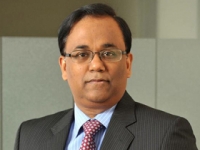Last year your company made it to the top ten fund houses in terms of AUM. What has contributed to this growth?
When we started in 2009, we were the 40th fund house. Over the years, we have seen phenomenal growth.
A few things have helped us grow. We have come out with a few right products where we feel we have expertise.
Second, we are mindful of our product communication. We follow a need-based approach to market our products instead of a product-based approach. For instance, we talk about what clients need instead of what we offer.
Third, how we interact with the distributors is important. Some of the innovations has helped our partners to increase their efficiency while servicing their clients. This has resulted in higher productivity and higher business growth for both of us.
Finally, the brand Axis Bank has been supporting us for nine years.
What is your roadmap for the company for the next three years?
We want to double our AUM to reach Rs.2 lakh crore in two years. We will continue to do what we are doing.
You were the fund manager earlier and now you are the CEO. What is the key difference in managing people’s money and running a company? What are the learnings you imbibed from fund management that has helped you manage the fund house?
I can say I have learnt managing and assessing risk from fund management and that has helped me in the current role. Fund managers assess risk, look at the future prospects and estimate future cash flow before investing in a company. These skills have helped me look at various parameters before taking any business decision.
Axis Long Term Equity Fund has assets over Rs.16,000 crore. However, other equity funds have not grown substantially. What are you doing to popularise other schemes?
Axis Long Term Equity Fund is certainly a very popular product. Maybe this is the reason why other funds are not so popular. If the fund was not so popular, we could have witnessed a good growth in the other products as well.
However, with scheme rationalisation, there is an opportunity to position our products in the right category. In addition, we have launched two new products in 2017 that received good response during NFOs.
What are you doing to increase contribution from other distribution channels?
The distributor-oriented initiative, Shubhchintak, focuses on the growth of IFA business. Already nearly 4,000 people are on board. The platform is helping them grow their business. Currently, around 60% of the active distributors are associated with us.
There have been reports that Axis MF is planning to set up an AIF. What is the rationale behind this?
We find that meaningful innovation is not possible in mutual funds. On the other hand, alternative investment funds provide flexibility.
In mutual funds, the funds are index linked which is not so in case of an AIF. Also, we would like to provide investors with all kinds of products and services.
We got approval for the AIF and we will be launching it in some time. It will be a late stage private equity product.
SEBI wants AMCs to reduce TER. What do you think of the scope of reducing TER in mutual funds?
I do not think that there is much scope for reducing TER. Looking at the international practices many believe that Indian MF industry should come out with low cost products. In my view, fund houses can gradually reduce up to 10-15% of the overall TER over the next seven years.
If such a reduction comes abruptly, it will be disruptive for the industry, as it will disrupt margins of AMCs and distributors.
Going forward, I believe that fund houses will have to charge performance based fee.





